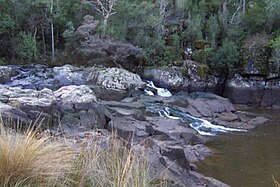| Supply | |
|---|---|
 A small series of rapids near the river mouth | |
| Location | |
| Country | Australia |
| State | Tasmania |
| Region | Northern Tasmania |
| Physical characteristics | |
| Source | Mount Careless Forest Reserve |
| • location | below Kellys Lookout |
| • coordinates | 41°18′5″S 146°46′6″E / 41.30139°S 146.76833°E |
| • elevation | 416 m (1,365 ft) |
| Mouth | Tamar River |
• location | Supply Bay, Robigana |
• coordinates | 41°15′28″S 146°56′48″E / 41.25778°S 146.94667°E |
• elevation | 0 m (0 ft) |
| Length | 27 km (17 mi) |
| Basin features | |
| River system | Tamar River |
| Tributaries | |
| • left | Rookery Creek |
| • right | Tunks Creek |
| [1] | |
The Supply River is a perennial river located in the northern region of Tasmania, Australia.
Location and features
[edit]The river rises below Kellys Lookout within the Mount Careless Forest Reserve, southwest of Beaconsfield and west of Exeter. The river flows generally east-northeast, joined by two minor tributaries before reaching its confluence with the Tamar River at Robigana. From this point, the river enters the Bass Strait. The river descends 416 metres (1,365 ft) over its 27-kilometre (17 mi) course.[1] The river is transversed by the West Tamar Highway.
The river draws its name from the supply of fresh water at a waterfall just 500 metres (1,600 ft) from the river mouth, discovered in 1804 when the Lady Nelson sailed up the Tamar River.[2] A water mill was built c. 1825, approximately 30 kilometres (19 mi) north of Launceston, upstream of the junction of the Tamar and Supply rivers.[3][4] A 500-metre (1,600 ft) walking trail leads from the river mouth to the water mill.[5]
See also
[edit]References
[edit]- ^ a b "Map of Supply River, TAS". Bonzle Digital Atlas of Australia. 2015. Retrieved 18 March 2017.
- ^ Parish, Steve. Australian Touring Atlas. Archerfield, Queensland: Steve Parish Publishing. p. 55. ISBN 978-1-74193-232-4.
- ^ Pearson, Warwick (1997). "Water-Powered Flourmills in Nineteenth-Century Tasmania" (PDF). Australasian Historical Archaeology. 15.
- ^ Walker, Tim (13 March 2013). "Launceston's colonial past revealed". ABC Northern Tasmania. Australia. Retrieved 18 March 2017.
- ^ "PWS Concessions - Walking Track List - AS2156 classes 1 to 4". Parks Tasmania. 12 March 2009. Retrieved 18 March 2017.
External links
[edit]- "Swollen Supply River near Exeter, Tasmania". ABC News. Tasmania, Australia. 31 August 2013.
